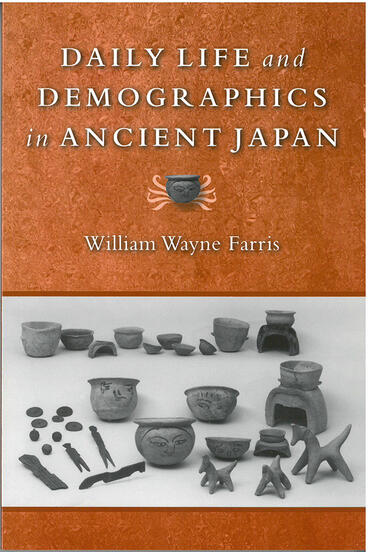Daily Life and Demographics in Ancient Japan
Explores the daily life of the citizens of the lost periods of ancient Japan
Description
For centuries, scholars have wondered what daily life was like for the common people of Japan, especially for long bygone eras such as the ancient age (700–1150). Using the discipline of historical demography, William Wayne Farris shows that for most of this era, Japan’s overall population hardly grew at all, hovering around six million for almost five hundred years. The reasons for the stable population were complex. Most importantly, Japan was caught up in an East Asian pandemic that killed both aristocrat and commoner in countless numbers every generation. These epidemics of smallpox, measles, mumps, and dysentery decimated the adult population, resulting in wide-ranging social and economic turmoil. Famine recurred about once every three years, leaving large proportions of the populace malnourished or dead. Ecological degradation of central Japan led to an increased incidence of drought and soil erosion. And war led soldiers to murder innocent bystanders in droves. Under these harsh conditions, agriculture suffered from high rates of field abandonment and poor technological development. Both farming and industry shifted increasingly to labor-saving technologies. With workers at a premium, wages rose. Traders shifted from the use of money to barter. Cities disappeared. The family was an amorphous entity, with women holding high status in a labor-short economy. Broken families and an appallingly high rate of infant mortality were also part of kinship patterns. The average family lived in a cold, drafty dwelling susceptible to fire, wore clothing made of scratchy hemp, consumed meals just barely adequate in the best of times, and suffered from a lack of sanitary conditions that increased the likelihood of disease outbreak. While life was harsh for almost all people from 700 to 1150, these experiences represented investments in human capital that would bear fruit during the medieval epoch (1150–1600).
William Wayne Farris received his doctorate from Harvard University in 1981 and now holds the Sen Soshitsu XV Distinguished Chair in Japanese History and Culture at the University of Hawaii at Manoa. His research and writing have focused on the social and economic history of Japan to 1700, including such topics as disease and famine, agricultural technology and commerce, and aspects of the daily life of the common people. His major publications include Population, Disease, and Land in Early Japan, 645-900 (Harvard University, 1985), Heavenly Warriors: The Evolution of Japan’s Military, 500-1300 (Harvard University, 1992), Sacred Texts and Buried Treasures: Issues in the Historical Archaeology of Ancient Japan (University of Hawaii, 1998), and Japan’s Medieval Population: Famine, Fertility, and Warfare in a Transformative Age (University of Hawaii, 2006), which was named as an Outstanding Academic Title for 2006.
Reviews
"Researchers and educators in the fields of premodern Japanese history and historical demography will find Daily Life and Demographics a useful and welcome addition to their libraries." —Bruce L. Batten, Journal of Japanese Studies
"[An] exceedingly lucid survey of what is and can be known about the demographics of ancient Japan."—Ross Bender, PMJS Papers
"The work in this book is foundational for future research. This very readable, engaging, and straightforward book ... will surely be widely read and pondered both by specialists and by those with a general interest in the social and economic history of Japan."—Joan R. Piggott, International Journal of Asian Studies

